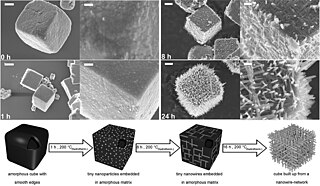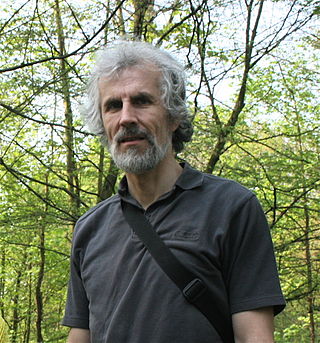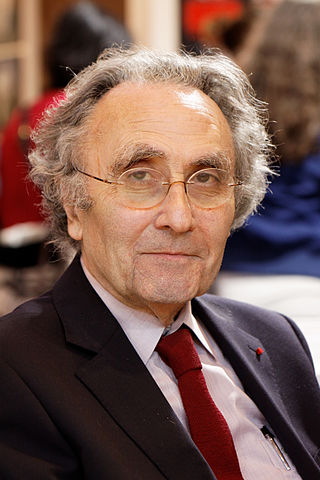Related Research Articles
Systems theory is the transdisciplinary study of systems, i.e. cohesive groups of interrelated, interdependent components that can be natural or artificial. Every system has causal boundaries, is influenced by its context, defined by its structure, function and role, and expressed through its relations with other systems. A system is "more than the sum of its parts" when it expresses synergy or emergent behavior.
Warren Sturgis McCulloch was an American neurophysiologist and cybernetician, known for his work on the foundation for certain brain theories and his contribution to the cybernetics movement. Along with Walter Pitts, McCulloch created computational models based on mathematical algorithms called threshold logic which split the inquiry into two distinct approaches, one approach focused on biological processes in the brain and the other focused on the application of neural networks to artificial intelligence.

Heinz von Foerster was an Austrian-American scientist combining physics and philosophy, and widely attributed as the originator of second-order cybernetics. He was twice a Guggenheim fellow and also was a fellow of the American Association for the Advancement of Science, 1980. He is well known for his 1960 Doomsday equation formula published in Science predicting future population growth.

Self-organization, also called spontaneous order in the social sciences, is a process where some form of overall order arises from local interactions between parts of an initially disordered system. The process can be spontaneous when sufficient energy is available, not needing control by any external agent. It is often triggered by seemingly random fluctuations, amplified by positive feedback. The resulting organization is wholly decentralized, distributed over all the components of the system. As such, the organization is typically robust and able to survive or self-repair substantial perturbation. Chaos theory discusses self-organization in terms of islands of predictability in a sea of chaotic unpredictability.

William Ross Ashby was an English psychiatrist and a pioneer in cybernetics, the study of the science of communications and automatic control systems in both machines and living things. His first name was not used: he was known as Ross Ashby.
Second-order cybernetics, also known as the cybernetics of cybernetics, is the recursive application of cybernetics to itself and the reflexive practice of cybernetics according to such a critique. It is cybernetics where "the role of the observer is appreciated and acknowledged rather than disguised, as had become traditional in western science". Second-order cybernetics was developed between the late 1960s and mid 1970s by Heinz von Foerster and others, with key inspiration coming from Margaret Mead. Foerster referred to it as "the control of control and the communication of communication" and differentiated first-order cybernetics as "the cybernetics of observed systems" and second-order cybernetics as "the cybernetics of observing systems".

Francis Paul Heylighen is a Belgian cyberneticist investigating the emergence and evolution of intelligent organization. He presently works as a research professor at the Vrije Universiteit Brussel, where he directs the transdisciplinary "Center Leo Apostel" and the research group on "Evolution, Complexity and Cognition". He is best known for his work on the Principia Cybernetica Project, his model of the Internet as a global brain, and his contributions to the theories of memetics and self-organization. He is also known, albeit to a lesser extent, for his work on gifted people and their problems.

Andrew Gordon Speedie Pask was a British cybernetician, inventor and polymath who made during his lifetime multiple contributions to cybernetics, educational psychology, educational technology, epistemology, chemical computing, architecture, and the performing arts. During his life he gained three doctorate degrees. He was an avid writer, with more than two hundred and fifty publications which included a variety of journal articles, books, periodicals, patents, and technical reports. He also worked as an academic and researcher for a variety of educational settings, research institutes, and private stakeholders including but not limited to the University of Illinois, Concordia University, the Open University, Brunel University and the Architectural Association School of Architecture. He is known for the development of conversation theory.
A glossary of terms relating to systems theory.
New Cybernetics, as used by cybernetician Gordon Pask, is the meaningful transfer of information between coherences in all media in terms of attractions and repulsions between clockwise and anti-clockwise spins. This is a possibly defining paradigm of the new cybernetics or second-order cybernetics.
A cyberneticist or a cybernetician is a person who applies cybernetics.
Conversation theory is a cybernetic approach to the study of conversation, cognition and learning that may occur between two participants who are engaged in conversation with each other. It presents an experimental framework heavily utilizing human-computer interactions and computer theoretic models as a means to present a scientific theory explaining how conversational interactions lead to the emergence of knowledge between participants. The theory was developed by Gordon Pask, who credits Bernard Scott, Dionysius Kallikourdis, Robin McKinnon-Wood, and others during its initial development and implementation as well as Paul Pangaro during subsequent years.

Stuart Anspach Umpleby is an American cybernetician and professor in the Department of Management and Director of the Research Program in Social and Organizational Learning in the School of Business at the George Washington University.

Henri Atlan is a French biophysicist and philosopher.

Cybernetics is a field of systems theory that studies circular processes, such as feedback systems where outputs are also inputs. It is concerned with the general principles of circular causal processes, including in ecological, technological, biological, cognitive and social systems and also in the context of practical activities such as designing, learning, and managing.
The Biological Computer Laboratory (BCL) was a research institute of the Department of Electrical Engineering at the University of Illinois Urbana-Champaign. It was founded on 1 January 1958, by then Professor of Electrical Engineering Heinz von Foerster. He was head of BCL until his retirement in 1975.
In information theory, Interactions of actors theory is a theory developed by Gordon Pask and Gerard de Zeeuw. It is a generalisation of Pask's earlier conversation theory: The chief distinction being that conversation theory focuses on analysing the specific features that allow a conversation to emerge between two participants, whereas interaction of actor's theory focuses on the broader domain of conversation in which conversations may appear, disappear, and reappear over time.
The Symposium on Principles of Self-Organization was held at Allerton House on 8–9 June 1960. It was a key conference in the development of cybernetics and was in many ways a continuation of the Macy Conferences. it was organised by Heinz von Foerster through the Biological Computer Laboratory based at University of Illinois at Urbana-Champaign. It was sponsored by the Information Systems Branch of the U.S. Office of Naval Research.

Jason Jixuan Hu, is a Chinese American cyberneticist, independent scholar and managing director of WINTOP Organizational Learning Laboratory, and organizer/facilitator of the Club of Remy(Youtube Channel). He is noted for his work on "cognitive capacity in human communication, conflict resolution and cooperation solicitation," and on view on distance education in America.
References
- 1 2 Ashby, W. R. (1947). "Principles of the Self-Organizing Dynamic System". The Journal of General Psychology. 37 (2): 125–8. doi:10.1080/00221309.1947.9918144. PMID 20270223.
- ↑ Ashby, W. R. (1962). "Principles of the self-organizing system", pp. 255–278 in Principles of Self-Organization. Heinz von Foerster and George W. Zopf, Jr. (eds.) U.S. Office of Naval Research.
- ↑ Von Foerster, H. (1960). "On self-organizing systems and their environments", pp. 31–50 in Self-organizing systems. M.C. Yovits and S. Cameron (eds.), Pergamon Press, London
- ↑ Asaro, P. (2007). "Heinz von Foerster and the Bio-Computing Movements of the 1960s" in Albert Müller and Karl H. Müller (eds.) An Unfinished Revolution? Heinz von Foerster and the Biological Computer Laboratory BCL 1958–1976. Vienna, Austria: Edition Echoraum.
- ↑ See occurrences on Google Books.
- ↑ François, Charles, ed. (2011) [1997]. International Encyclopedia of Systems and Cybernetics (2nd ed.). Berlin: Walter de Gruyter. p. 107. ISBN 978-3-1109-6801-9.
- ↑ See occurrences on Google Books.
- ↑ ""complexité par le bruit""L'Organisation biologique et la théorie de l'information" 1972 - Google Search". www.google.com.
- ↑ ""complexité par le bruit""Entre le cristal et la fumée" 1979 - Google Search". www.google.com.
- ↑ Nicolis, G. and Prigogine, I. (1977). Self-organization in nonequilibrium systems: From dissipative structures to order through fluctuations. Wiley, New York.
- ↑ Prigogine, I. and Stengers, I. (1984). Order out of chaos: Man's new dialogue with nature. Bantam Books.
- ↑ Ahmed, Furqan; Tirkkonen, Olav (January 2016). "Simulated annealing variants for self-organized resource allocation in small cell networks". Applied Soft Computing. 38: 762–770. doi:10.1016/j.asoc.2015.10.028. S2CID 10126852.
- ↑ Wiener, Norbert (1962) "The mathematics of self-organising systems". Recent developments in information and decision processes, Macmillan, N. Y. and Chapter X in Cybernetics, or control and communication in the animal and the machine, The MIT Press.
- ↑ Cybernetics, or control and communication in the animal and the machine, The MIT Press, Cambridge, Massachusetts and Wiley, NY, 1948. 2nd Edition 1962 "Chapter X "Brain Waves and Self-Organizing Systems"pp 201–202.
- ↑ Eric K. Drexler "Engines of Creation" 1986
- ↑ "Engines of Creation 2" (PDF). Archived from the original (PDF) on 2014-08-10.
- ↑ Ashby, William Ross (1952) Design for a Brain, Chapter 5 Chapman & Hall
- ↑ Ashby, William Ross (1956) An Introduction to Cybernetics, Part Two Chapman & Hall
- ↑ Conant, Roger C.; Ross Ashby, W. (8 March 2007). "Every good regulator of a system must be a model of that system". International Journal of Systems Science. 1 (2): 89–97. doi:10.1080/00207727008920220.
- ↑ Embodiments of Mind MIT Press (1965)"
- ↑ von Foerster, Heinz; Pask, Gordon (1961). "A Predictive Model for Self-Organizing Systems, Part I". Cybernetica. 3: 258–300.
- ↑ von Foerster, Heinz; Pask, Gordon (1961). "A Predictive Model for Self-Organizing Systems, Part II". Cybernetica. 4: 20–55.
- ↑ "Brain of the Firm" Alan Lane (1972) see also "Beyond Dispute," Wiley, Stafford Beer 1994 "Redundancy of Potential Command" pp. 157–158.
- 1 2 Pask, Gordon (September 1996). "Heinz von Foerster's Self Organization, the Progenitor of Conversation and Interaction Theories". Systems Research. 13 (3): 349–362. doi:10.1002/(sici)1099-1735(199609)13:3<349::aid-sres103>3.3.co;2-7.
- ↑ Pask, G. (1973). Conversation, Cognition and Learning. A Cybernetic Theory and Methodology. Elsevier
- ↑ Green, Nick (July 2001). "On Gordon Pask". Kybernetes. 30 (5/6): 673–682. doi:10.1108/03684920110391913.
- ↑ Pask, Gordon (1993) Interactions of Actors (IA), Theory and Some Applications.
- ↑ Laughlin, R. B.; Pines, David (4 January 2000). "The Theory of Everything". Proceedings of the National Academy of Sciences of the United States of America. 97 (1): 28–31. doi: 10.1073/pnas.97.1.28 . PMC 26610 . PMID 10618365.